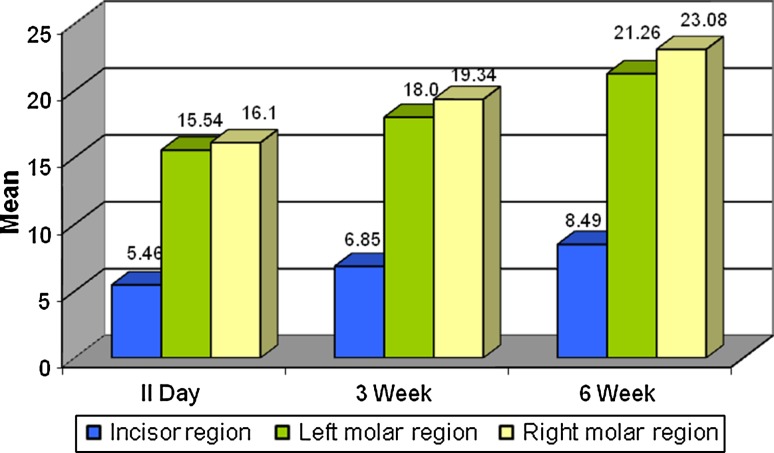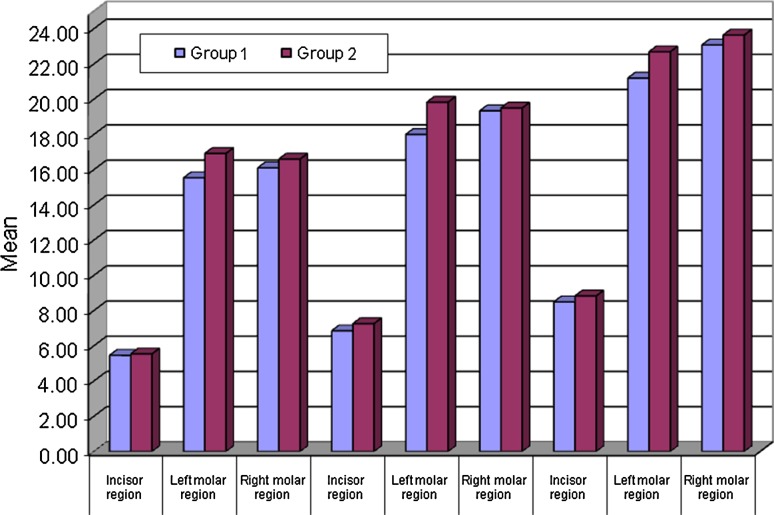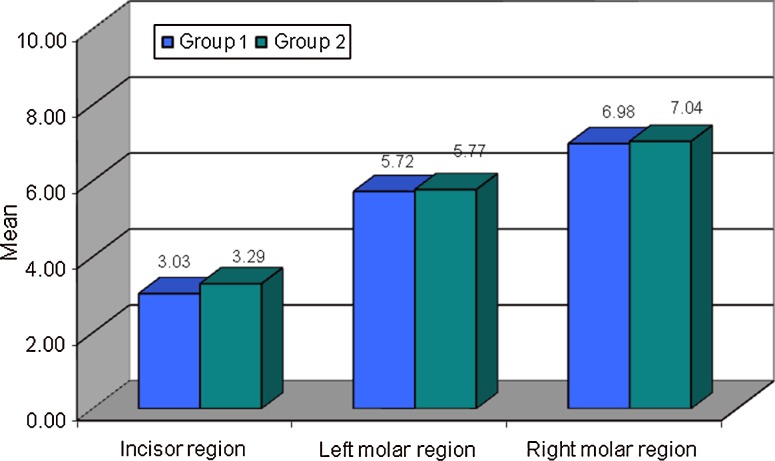Abstract
Aims and Objectives
To compare and evaluate the variation in recorded bite forces in patients with mandibular fractures undergoing open reduction and rigid internal fixation using standard 2.0 versus 2.0 mm locking miniplates.
Materials and Methods
A prospective randomized study was conducted for the treatment of mandibular fractures. Twenty adult patients with 31 mandibular fractures requiring an open reduction and internal fixation were included in the study. The sample was divided into two groups depending upon whether the patients received 2.0 mm non-locking (standard) or 2.0 mm locking miniplates for rigid fixation respectively. Bite force was evaluated at 1st, 3rd and 6th week after the open reduction and rigid fixation using miniplates.
Results
A statistically significant difference was not found in the clinical parameters such as pain, swelling, infection, paresthesia, hardware failure, and mobility between the fracture segments. The results showed that amongst locking vs non-locking miniplates, the former showed a greater bite force enhancement when compared to baseline values(post-trauma).A comparison between 2nd day post-operative vs 6th week post-operative values showed a significant increase in bite force in Group 1 (non-locking) (p < 0.05) whereas the values Were highly significant (p < 0.001) in Group 2 (locking Plate).
Conclusion
The findings were suggestive that the efficacy of locking miniplates plate in mandibular fracture was superior in terms of bearing the masticatory loads during osteosynthesis of the fracture. However, the clinical results were almost similar to those seen with non-locking miniplate osteosynthesis.
Keywords: Bite force, Locking plates, Non-locking plates, Bite meter
Introduction
The sheer pace of modern life with high speed travel as well as an increasingly violent and intolerant society have made facial trauma a form of social disease from which no one is immune. The aim of mandibular fracture treatment is to restore anatomical form and function, with particular care to re-establish the occlusion and hence the bite force. Since the past two decades the aim of treatment modalities has shifted more towards immediate return of normal jaw function by using different methods of open reduction and internal fixation. The advantages of these methods are convenience to the patient and for secondary reasons such as to maintain normal joint function and avoid the complications of immobilization [1]. Various methods of bone plating have been developed to provide stable fixation for mandibular fractures and osteotomies. Miniplate osteosynthesis, first introduced by Michelet in 1973 [2] and further developed by Champy et al. [3] in 1978, is the current standard for the treatment of mandibular fracture. Miniplate system, either locking or non-locking, has revolutionized the fixation of mandible fractures. A disadvantage of conventional miniplate systems has been that the plate must be perfectly adapted to the underlying bone to prevent alterations in the alignment of the segments and changes in the occlusal relationship. With conventional bone plating systems, stability is achieved when the head of the screw compresses the fixation plate to the bone [4]. A unique advantage of locking systems is that it becomes unnecessary for the plate to have intimate contact with the underlying bone, making plate adaptation easier. The relationship of the bite force to the method of fixation has been studied previously by some authors. The pioneering work of Gerlach and Schwarz [5] revealed that the maximal bite force in patients with mandibular fractures treated with miniplate osteosynthesis had reached only 31 % at 1 week postoperatively compared with a healthy control group. This value had increased to 58 % at 6 weeks postoperatively. Mohit et al. [6] further emphasized the role of adequate fixation by reporting a statistically significant increase in the bite force on subsequent visits in patients with locking miniplates than non-locking miniplates. The present study was undertaken with the aim to compare the variation in the recorded bite force following open reduction and rigid fixation using 2 mm locking plates with 2 mm conventional miniplates in fixation of mandibular fractures.
Materials and Methods
A prospective randomized study was conducted at the Department of Oral and Maxillofacial Surgery, from June, 2012 to August, 2014. The institutional reviewer guidelines were followed and local ethical committee had approved the study. Twenty healthy adult patients, who strictly met the inclusion criteria, were included in the study. Preoperatively, a detailed medical examination was done. The diagnosis was made on the basis of the clinical examination findings and radiographic interpretation. Routine investigations were performed. All patients provided informed consent before participating in the present study. Randomization of consecutive patients was done, irrespective of age, gender, caste, and creed by allocating them into their respective study groups using chit withdrawal system in which both the patient and the operator were unaware of the specifics; inclusion criteria consisted of fractures which were non comminuted, and open reduction and internal fixation was indicated. The exclusion criteria were mandibular fracture with infection and a history of diabetes, prolonged steroid therapy, compromised immunity, or associated bone pathologic features, and concomintant condylar fractures.
All patients were randomly categorized into two groups with 10 patients each. Group 1 received conventional or standard 2 mm non-locking miniplate system with a profile height of 1 mm and fixed using self tapping screws of 6, 8 and 10 mm length. Group 2 received 2 mm locking miniplate plate/screw system with a profile height of 1 mm and fixed using self tapping screws of 6, 8 and 10 mm length. All the procedures were carried out under general anesthesia under naso-endotracheal intubation using the standard operating conditions. The surgical technique was same for both the groups. All patients were put into intermaxillary fixation with elastics for 7–10 days. The cause of trauma, interval from injury to surgery, average age, gender, and site distribution were all assessed. Follow-up was done at 1, 3, and 6 weeks. The following clinical parameters were assessed for each patient at each follow-up visit: pain (visual analog scale 1–10), swelling, infection, paresthesia, hardware failure (plate fracture), mobility between fracture fragments, and bite force recording at the incisor, right molar, and left molar regions.
All bite force measurements were made using an indigenous Bite Force Recorder, designed at RDSO (Research Designs and Standard Organization), Lucknow (Fig. 1). The Recorder consists of four strain gauges mounted on steel bars, forming a wheatstone bridge. Load changes in the steel bar produce a measurable voltage change across the four strain gauge, then were converted into kilogram force. All measurements were made with the subject seated with the head upright, looking forward and in an unsupported natural head position. The subjects were asked to remain in this position throughout the trial and to refrain from extraneous movement. Bite forces were measured at the incisor and right and left molar regions taken as reference points. The subjects were instructed to bite on the pads of bite force gauge to the maximum level. (Figs. 2, 3). This was accomplished by instructing the subject to bite as forcefully as possible and bite force values were recorded. Calibrations of the strain gauge unit were done outside the mouth before and after every bite sequence and when calibrations deferred records obtained in the mouth were discarded.
Fig. 1.
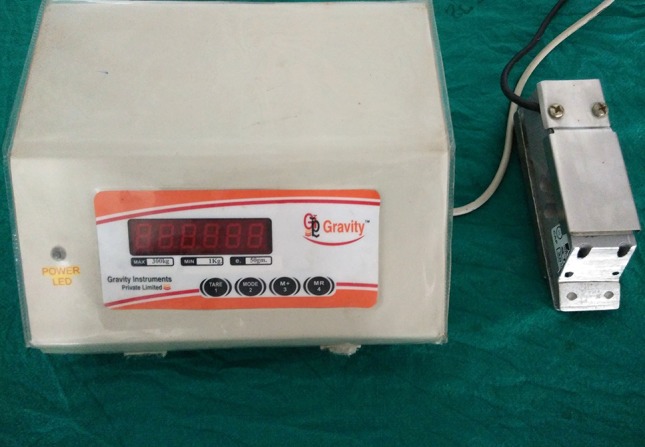
Bite meter used for bite force evaluation
Fig. 2.
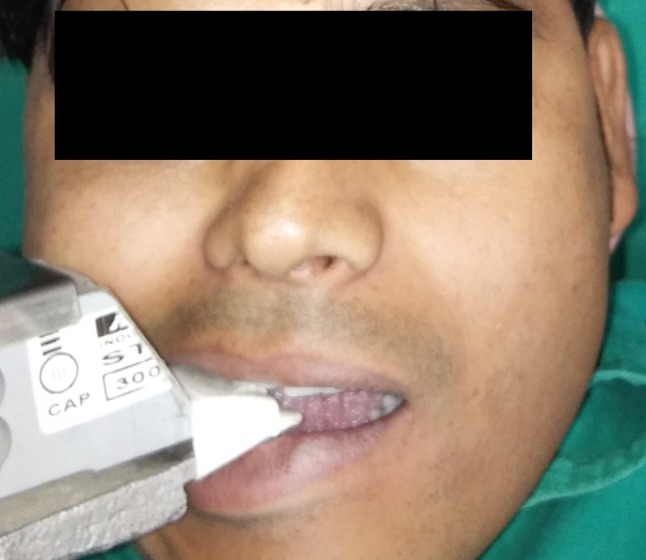
Biting measurement of the right mandibular first molar
Fig. 3.
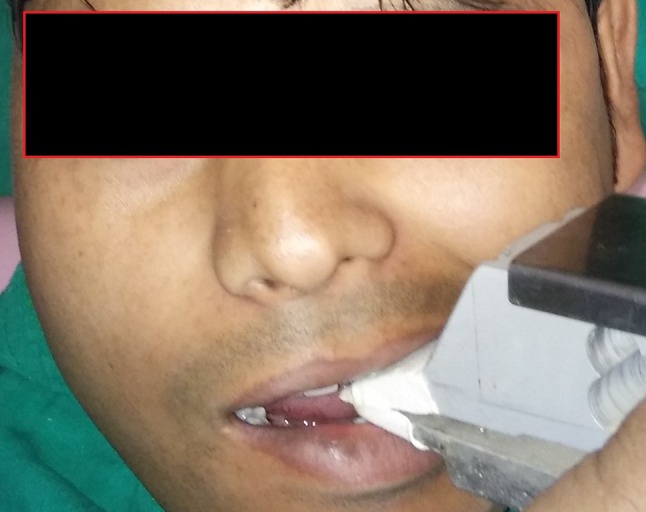
Biting measurement of the left mandibular first molar
Statistical Analysis
The clinical parameters were assessed and analyzed by using a computer program statistics (SPSS Version 10.0; SPS Inc, Chicago, IL). The data was analyzed using mean, standard deviation, Chi square test, and student “t” test (paired test) and results were produced.
Results
A total number of 20 patients with 31 fractures met the inclusion criteria and were included in the present study. In Group 1, 10 patients with mandibular fractures underwent osteosynthesis using conventional 2.0 mm non-locking miniplates. In Group 2, 10 patients with mandibular fractures underwent osteosynthesis using the 2.0 mm locking miniplates. The most common cause of injury was road traffic accidents (80 % of cases). The patients were divided into 3 age groups: 11–20, 21–30, 31–40, the most common age group was 11–20 years (40 %).More patients were males (85 %) than females (15 %). Parasymphysis was the most commonly involved site, followed by the body of the mandible. Although, the preoperative occlusion was deranged in all the patients in both groups but, functional occlusion was achieved in all patients in both the groups. The patients were divided into 4 groups according to the interval from injury to treatment: 1–3, 4–7, 8–11, and 12 to 15 days. Most patients (55 %) were treated within 4–7 days of injury, and mean interval between injury and treatment was 7.5 days. No statistically significant difference was found in the clinical parameters among two groups. Incidence of swelling was less in Group 2 than Group 1 at different time intervals. No incidence of swelling was found in Group 2 at 3rd and 6th week. But in Group 1 swelling was present in 2 patients (20 %) at 3rd and 6th week. This difference was not statistically significant. A significant decrease in pain occurred from 1 to 6 weeks in both groups. No pain was observed at the 6 weeks follow-up visit in either group. No significant difference in the pain experienced was found between groups 1 and 2 at the different follow-up visits. In Group 1 parasthesia was present in one patient (10 %) at 2nd day and it resolved at 3rd and 6th week. In Group 2 parasthesia was present in 2 patients (20 %) which resolved at 2nd day, 3rd week and 6th week. There was non-significant difference in paresthesia in Group 1 and Group 2 at different time intervals. At 6 weeks in Group 1, 2 patients presented with infection; no patient in Group 2 presented with infection; however, the difference was not significant.
In Group 1, the incisor bite force increased significantly at the progressive follow-up visits compared with that recorded preoperatively. In Group 2, the incisor bite force had also increased significantly at the progressive follow-up visits. From 1 to 6 weeks, the change in the incisor bite force was significantly greater in Group 2 than in Group 1. At 3 and 6 weeks, no significant difference was observed in the change in the incisor bite force in Groups 1 and 2. In Group 1, the right molar bite force had increased significantly at the progressive follow-up visits. In Group 2, the right molar bite force had also increased significantly at the progressive follow-up visits. From 3 weeks to 6 weeks, the change in the right molar bite force from the previous follow-up visit was significantly greater in Group 2 than in Group 1. At 1 and 3 weeks, no significant difference was observed in the change in the right molar bite force of Groups 1 and 2. In Group 1, the left molar bite force had increased significantly at the progressive follow-up visits. In Group 2, the left molar bite force had also increased significantly at the progressive follow-up visits. At 1, 3, and 6 weeks, the change in left molar bite force from the previous follow-up visit was significantly greater in Group 2 than in Group 1. (Tables 1, 2, 3, 4; Figs. 4, 5, 6, 7).
Table 1.
Bite force in Group 1
| (a) | 2nd day (mean ± SD) | 3rd week (mean ± SD) | 6th week (mean ± SD) |
|---|---|---|---|
| Incisor region | 5.46 ± 1.22 | 6.85 ± 1.59 | 8.49 ± 1.38 |
| Left molar region | 15.54 ± 4.26 | 18.0 ± 4.97 | 21.26 ± 5.70 |
| Right molar region | 16.10 ± 4.46 | 19.34 ± 4.99 | 23.08 ± 5.99 |
| (b) | Incisor region | Left molar region | Right molar region | |||
|---|---|---|---|---|---|---|
| t | p | t | p | t | p | |
| 2nd day versus 3rd week | 0.62 | >0.05 | 1.20 | >0.05 | 1.55 | >0.5 |
| 2nd day versus 6th week | 5.27 | <0.001 | 2.57 | <0.05 | 2.99 | <0.01 |
| 3rd week versus 6th week | 2.49 | <0.05 | 1.37 | >0.05 | 1.54 | >0.05 |
Table 2.
Bite force in Group 2
| (a) | 2nd day (mean ± SD) | 3rd week (mean ± SD) | 6th week (mean ± SD) |
|---|---|---|---|
| Incisor region | 5.54 ± 1.67 | 7.26 ± 1.96 | 8.83 ± 1.97 |
| Left molar region | 16.92 ± 2.87 | 19.83 ± 2.19 | 22.69 ± 2.09 |
| Right molar region | 16.60 ± 3.45 | 19.50 ± 2.17 | 22.79 ± 3.39 |
| (b) | Incisor region | Left molar region | Right molar region | |||
|---|---|---|---|---|---|---|
| t | p | t | p | t | p | |
| 2nd day versus 3rd week | 2.12 | <0.05 | 2.42 | <0.05 | 2.27 | <0.05 |
| 2nd day versus 6th week | 4.08 | <0.001 | 5.56 | <0.001 | 4.05 | <0.001 |
| 3rd week versus 6th week | 1.79 | >0.05 | 3.74 | >0.01 | 2.61 | <0.01 |
Table 3.
Comparison of bite force in Group 1
and Group 2 at different time intervals for different teeth
| Bite force | Group 1 mean ± SD | Group 2 mean ± SD | t | p | Sig. |
|---|---|---|---|---|---|
| 2nd day | |||||
| Incisor region | 5.46 ± 1.22 | 5.54 ± 1.67 | 0.12 | 0.90 | NS |
| Left molar region | 15.54 ± 4.26 | 16.92 ± 2.87 | 0.84 | 0.40 | NS |
| Right molar region | 16.10 ± 4.46 | 16.60 ± 3.45 | 0.28 | 0.80 | NS |
| 3 week | |||||
| Incisor region | 6.85 ± 1.59 | 7.26 ± 1.96 | 0.51 | 0.62 | NS |
| Left molar region | 18.0 ± 4.97 | 19.83 ± 2.19 | 1.06 | 0.30 | NS |
| Right molar region | 19.34 ± 4.99 | 19.50 ± 2.17 | 0.09 | 0.95 | NS |
| 6 week | |||||
| Incisor region | 8.49 ± 1.39 | 8.83 ± 1.97 | 0.44 | 0.66 | NS |
| Left molar region | 21.20 ± 5.70 | 22.69 ± 2.09 | 0.75 | 0.46 | NS |
| Right molar region | 23.08 ± 5.99 | 23.64 ± 3.02 | 0.13 | 0.90 | NS |
Table 4.
Comparison of bite force increase in Group 1 and Group 2
| Group 1(mean ± SD) | Group 2 (mean ± SD) | t | p | Sig. | |
|---|---|---|---|---|---|
| Incisor region | 3.03 ± 0.68 | 3.29 ± 0.92 | 0.73 | >0.05 | NS |
| Left molar region | 5.72 ± 1.98 | 5.77 ± 1.18 | 0.06 | >0.05 | NS |
| Right molar region | 6.98 ± 2.09 | 7.04 ± 1.68 | 0.94 | >0.05 | NS |
Fig. 4.
Bite force in Group 1
Fig. 5.
Bite force in Group 2
Fig. 6.
Comparison of bite force in Group 1 and Group 2 at different time intervals for different teeth
Fig. 7.
Comparison of bite force increase in Group 1 and Group 2
Discussion
The treatment of mandibular fractures has evolved significantly in the past few decades as rigid internal fixation has become increasingly popular with both patients and surgeons. Two general treatment philosophies emerged for plate and screw fixation of mandibular fractures in the 1970s and 1980s. The AO/ASIF philosophy, which promotes sufficient rigidity at the fracture site to prevent interfragmentary mobility during mandibular function, has traditionally been accomplished using large rigid plates and bicortical screws placed through an extra oral approach. A second philosophy, popularized by Champy et al. [7–10] emphasized “The Ideal Lines of Osteosynthesis” in the mandible. This technique uses non-compression monocortical miniplates placed through transoral incision in the region of optimal stress to neutralize tension. He also emphasizes that at the level of the horizontal ramus, the movement is almost only flexion, the force of which increases from the front to the back. In the anterior part of the mandible, anterior to the first premolar, the movement is mainly torsion. The forces become greater as they come nearer to the mandibular symphysis.
Although, the Champy’s principle is clinically well adapted among the surgeons, but, it is not without complications. Some surgeons believed that the conventional plates based on Chamy’s principle do not offer sufficient resistance [11]. Hence they used supplemental maxillomandibular fixation for several weeks following fixation with mini plates [12–18].
To overcome the problem of fracture displacement and at the same time retain the advantages of Champy’s conventional miniplates, the locking screw and locking plate system was introduced in maxillofacial region by Ralf et al. in 2003 [19]. This new design of Mini-Locking plate provided locking of the screws on both the plate and bone interface, on either side of the fracture. Thus a frame construct was achieved on either side of the fracture fragments. This provided better stability of the fracture fragments and thus better healing environment when compared to the conventional plates while still retaining the same miniature dimensions. Raveh et al. [20, 21] were the first to develop the concept of locking plates and screws in maxillofacial reconstructive surgeries. They introduced hollow-screw reconstruction plate (THORP).
In spite of all the advantages that these locking plates and screw offer to the surgeon, they are still far from being the perfect treatment modality. Though clinically more efficient than a conventional plate, the locking plate still has the same complication rates [22, 23].
The main disadvantage of the locking system is the cost. The extra cost to the patient will be considerable. The surgeon should be aware of the cost difference between the 2 systems before selecting a locking plate. The locking system requires only minor additions to the instrument armamentarium. The system requires perpendicular placement of the plate/screw interface; thus, a locking drill guide is required. The technical difficulty added to the case will be fairly minor. Postoperative intermaxillary fixation with elastics was done for 7–10 days in all our patients. Previous investigators have reported excellent results with 2.0-mm miniplate fixation and a short period of maxilla-mandibular fixation. Follow-up examinations at 1, 3, and 6 weeks is an acceptable follow-up protocol for studying mandible fractures compared with published studies.
The knowledge about forces that are countered in mandibular fractures have been derived from maximum voluntary bite force measurement, which in healthy adult may be in the order of 15.3 kPa in the incisor and, 48.3 and 49.3 kPa in left and right molar regions respectively [24]. The amount of force the subjects with fractures can generate is much less [6]. Sufficient internal fixation hardware must be applied to resist the maximum forces of mastication. By doing so, the stability of fracture segment is assured even under full function of the masticatory system [6].
Gerlach et al. (2002) [1] stated that maximum bite force in patients with mandibular fractures treated with Miniplate Osteosynthesis reaches only 31 % at 1 week postoperatively, compared to healthy control group. This value increases to 58 % at the 6th week postoperatively.
In our study there was increase in Bite Force in both the groups at subsequent follow-up but the increase of Bite Force at incisor, left molar region, right molar region was more in Group 2 (locking) than in Group 1 (non-locking), Taking 2nd day Bite Force as base line compared to 6th week bite force (Table 3) there was a significant increase in bite forces within Group 1 (non-locking) while the values were highly significant in Group 2 (locking) (Table 2a, b). It is supported by the fact that the screws, plate, and bone form a solid framework with higher stability in case of Locking Miniplate than the traditional Miniplate system [6, 25]. Hence patients can generate more bite force without putting up less pressure across a fracture gap in Locking Miniplate compared with the conventional non-locking 2.0 mm miniplate. But bite force achieved in patients of mandibular fracture treated either by locking or non- locking miniplates failed to meet the reported maximum voluntary bite force of a healthy adult (Tables 1a, 2a).Whereas the maximum bite force recorded at the incisor, left molar and right molar region in Group 1 were respectively 8.49 ± 1.38, 21.26 ± 5.70, 23.08 ± 5.99 kPa and that in Group 2 were 8.83 ± 1.97, 22.69 ± 2.09, 22.79 ± 3.39 kPa respectively in the same regions, these were no match for the baseline values in healthy adult volunteers as reported by Ellis and Throckmorton which were respectively 15.3, 48.3 and 49.3 for the caucasian population [24]. This could be attributed to the fact that neuromuscular protective mechanisms existing throughout the body prevent the subject to bite voluntarily beyond the zone of comfort. For instance, one of the first protective mechanism called into play when a fracture occurs is ‘muscle splinting’, where selective components of the neuromuscular system are activated or deactivated to take forces off the damaged bone. Moreover Bite Force is related to a number of factors such as tactile impulses, pain and pressure reception in periodontal ligament and number of residual teeth thereby limiting the patient’s ability to apply pre trauma bite force [26–27].
The main drawback of the study is that the sample size is small and more meta-analysis is needed before the locking miniplates are accepted in the main armamentarium of the craniomaxillofacial surgeons over the conventional mini- plates.
Conclusion
The current study suggested that there is an increase in the bite force values when locking plates were used, is significant statistically, suggests the use of locking plates in preference to conventional plates to achieve early mobility with assured stability in case of mandibular fractures. A more elaborate study is required to come to a definitive conclusion.
Conflict of interest
None.
Contributor Information
Kolli Yada Giri, Email: dr.kolligiriomfs@gmail.com.
Puneet Sahu, Email: puneetsahu1985@gmail.com.
Sanjay Rastogi, Email: docos79@gmail.com.
Ramakant Dandriyal, Email: drramakant03@rediffmail.com.
Sunil Mall, Email: sunilmall24@gmail.com.
Aishwarya Pratap Singh, Email: draishwaryapratapsingh@gmail.com.
Niranjana Prasad Indra B, Email: niranjanbvnbt@gmail.com.
Himanshu Pratap Singh, Email: drhimanshupratap@gmail.com.
References
- 1.Gerlach KL, Erle A. Surgical management of mandibular fractures, peterward booth: maxillofacial surgery. 2. London: Churchill Livingstone Publication; 1999. p. 57. [Google Scholar]
- 2.Michelet FX, Deymes J, Dessus B. Osteosynthesis with miniaturized screwed plates in maxilla-facial surgery. J Maxillofac Surg. 1973;1(2):79–84. doi: 10.1016/S0301-0503(73)80017-7. [DOI] [PubMed] [Google Scholar]
- 3.Champy M, Lodde JP, Schmitt R, et al. Mandibular osteosynthesis by miniature screwed plates via a buccal approach. J Maxillofac Surg. 1978;6:14. doi: 10.1016/S0301-0503(78)80062-9. [DOI] [PubMed] [Google Scholar]
- 4.Haug R, Street C, Goltz M. Does plate adaptation affect stability? A biomechanical comparison of locking and nonlocking plates. J Oral Maxillofac Surg. 2002;60:13–19. doi: 10.1053/joms.2002.35732. [DOI] [PubMed] [Google Scholar]
- 5.Gerlach KL, Schwarz A. Bite force in patient after treatment of mandibular angle fracture with miniplate osteosynthesis according to Champy. Int J Oral Maxillofac Surg. 2002;31:345. doi: 10.1054/ijom.2002.0290. [DOI] [PubMed] [Google Scholar]
- 6.Mohit A, Shadab M, Singh RK, Singh V. Prospective randomized clinical trial comparing bite force in 2-mm locking plates versus 2-mm standard plates in treatment of mandibular fractures. J Oral Maxillofac Surg. 2011;69:1995–2000. doi: 10.1016/j.joms.2010.10.014. [DOI] [PubMed] [Google Scholar]
- 7.Champy M, Lodde JP, Jaeger JH, et al. Osteosynthesesmandbulairesselon la techniquee de Michelet. I. Bases biomechaniques. Rev Stomatol. 1976;77:569. [PubMed] [Google Scholar]
- 8.Champy M, Lodde JP. Etude des contraintesdans la mandibule fracture chezl’homme: measures theoriqueset verification par jaugesextensometriques in situ. Rev Stomatol. 1977;78:545. [PubMed] [Google Scholar]
- 9.Champy M, Lodde JP, Grasset D, et al. Osteosynthesesmandibulaire set compression. Ann Chir Plast. 1977;22:165. [PubMed] [Google Scholar]
- 10.Champy M, Lodde JP, Wilk A, et al. Probleme und ResultatebeiderVerwendung vonde hnungsmestreifen am prapariertenunterkieferundbeiPatientenmitunterkieferfrakturen. Dtsch Z Mund Kiefer GesichtsChir. 1978;2:41. [Google Scholar]
- 11.Sequin P, Béziat JL, Freidel M, Achard R, Dumas P. Development of treatments and results of mandibular fractures from 1950 to 1978 at the University Centre Hospital in Lyon. Rev Stomatol Chir Maxillofac. 1989;90(5):301–304. [PubMed] [Google Scholar]
- 12.Ellis E. Rigid skeletal fixation of fractures. Advances in OMFS 1943-1993. J Oral Maxillofac Surg. 1993;51:163–173. doi: 10.1016/S0278-2391(10)80016-3. [DOI] [PubMed] [Google Scholar]
- 13.Kuriakose MA, Fardy M, Sirikumara M, Patton DW, Sugar AW. A comparative review of 266 mandibular fractures with internal fixation using rigid (AO/ASIF) plates or mini-plates. Br J Oral Maxillofac Surg. 1996;34:315–321. doi: 10.1016/S0266-4356(96)90010-8. [DOI] [PubMed] [Google Scholar]
- 14.Gabrielli Marisa Aparecida Cabrini. Ma´rio Francisco Real Gabrielli, ElcioMarcantonio, and Eduardo Hochuli Vieira: fixation of mandibular fractures with 2.0-mm miniplates: review of 191 cases. J Oral Maxillofac Surg. 2003;61:430–436. doi: 10.1053/joms.2003.50083. [DOI] [PubMed] [Google Scholar]
- 15.Asprino Luciana, Consani Simonides, de Moraes Marcio. A comparative biomechanical evaluation of mandibular condyle fracture plating techniques. J Oral Maxillofac Surg. 2006;64:452–456. doi: 10.1016/j.joms.2005.11.017. [DOI] [PubMed] [Google Scholar]
- 16.Haug Richard H, Peterson Gilman P, Goltz Michele. A biomechanical evaluation of mandibular condyle fracture plating techniques. J Oral Maxillofac Surg. 2002;60:73–80. doi: 10.1053/joms.2002.29078. [DOI] [PubMed] [Google Scholar]
- 17.Choi BH, Huh JY, Suh CH, Kim KN. An invitro evaluation of miniplate fixation techniques for fractures of atropic edentulous mandible. Int J Oral Maxillofac Surg. 2005;34:174–177. doi: 10.1016/j.ijom.2003.10.024. [DOI] [PubMed] [Google Scholar]
- 18.Gerlach KL, Schwarz A. Bite forces in patients after treatment of Mandibular angle fractures with miniplate osteosynthesis according to Champy. Int J Oral Maxillofac Surg. 2002;31:345–348. doi: 10.1054/ijom.2002.0290. [DOI] [PubMed] [Google Scholar]
- 19.Ralf et al. (2003) Principles and stability of locking plates. Department of Oral and Maxillofacial Surgery, University of Freiburg, Germany (Keio). J Med 52(1): 21–24 [DOI] [PubMed]
- 20.Sutter F, Raveh J. Titanium-coated hollow screw and reconstruction plate system for bridging of lower jaw defects: biomechanical aspects. Int J Oral Maxillofac Surg. 1988;17(4):267–274. doi: 10.1016/S0901-5027(88)80055-9. [DOI] [PubMed] [Google Scholar]
- 21.Vuillemin T, Raveh J, Sutter F. Mandibular reconstruction with the titanium hollow screw reconstruction plate (THORP) system: evaluation of62 cases. Plast Reconstr Surg. 1988;82(5):804–814. doi: 10.1097/00006534-198811000-00013. [DOI] [PubMed] [Google Scholar]
- 22.Kirkpatrick D, Gandhi R, Van Sickels JE. Infections associated with locking reconstruction plates: a retrospective review. J Oral Maxillofac Surg. 2003;61(14):462–466. doi: 10.1053/joms.2003.50089. [DOI] [PubMed] [Google Scholar]
- 23.Collins CP, Pirinjian-Leonard G, Tolas A, Alcalde R. A prospective randomized clinical trial comparing 2.0-mm locking plates to 2.0-mm standard plates in treatment of mandible fractures. J Oral Maxillofac Surg. 2004;62:1392–1395. doi: 10.1016/j.joms.2004.04.020. [DOI] [PubMed] [Google Scholar]
- 24.Ellis E III, Throckmorton G (1994) Bite forces in patients treated for mandibular angle fractures: implications for fixation recommendations. J Oral Maxillofac Surg 52(7):734–736 [DOI] [PubMed]
- 25.Chritah A, Lazow SK, Berger JR. Transoral 2 mm locking miniplate fixation of mandibular fractures plus 1 week of maxillomandibular fixation: a prospective study. J Oral Maxillofac Surg. 2005;63:173. doi: 10.1016/j.joms.2004.06.051. [DOI] [PubMed] [Google Scholar]
- 26.Ellis E, III, Thockmorton GS. Bite forces after open or closed treatment of mandibular condylar process fractures. J Oral Maxillofac Surg. 2001;59:389–395. doi: 10.1053/joms.2001.21873. [DOI] [PubMed] [Google Scholar]
- 27.Shetty Vivek, McBrearty Daniel, Fourney Michael, Caputo Angelo A. Fracture line stability as a function of the internal fixation system: an invitro comparison using a mandibular angle fracture mode. J Oral Maxillofac Surg. 1995;53:791–801. doi: 10.1016/0278-2391(95)90335-6. [DOI] [PubMed] [Google Scholar]



